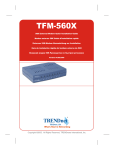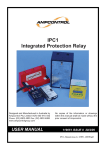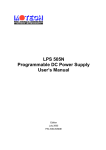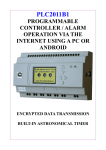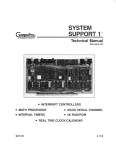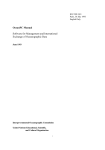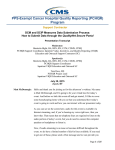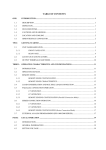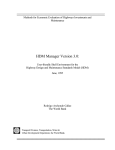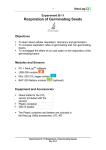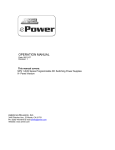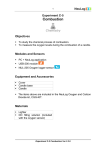Download Flow of Matter & Energy in Living Systems
Transcript
Released Open-Ended Items from the ATLAST Flow of Matter and Energy Teacher Assessment Horizon Research, Inc. (HRI) developed the ATLAST Flow of Matter and Energy Teacher Assessment as part of a larger study. The project—Assessing Teacher Learning About Science Teaching (ATLAST)—was funded by the National Science Foundation under Grant no. EHR0335328. Information about the ATLAST project is available at HRI’s ATLAST website: http://www.horizon-research.com/atlast. This document contains the flow of matter and energy teacher items that were developed during the process of creating the Flow of Matter and Energy Teacher Assessment. The items were developed during a months-long iterative process, and have been used with middle grades science teachers. However, there is little evidence of reliability and validity because the items were not developed in a rigorous process like the multiple choice items found on the assessments. To learn more about the item development process, please see the ATLAST Flow of Matter and Energy Teacher Assessment User Manual, which can be found at the ATLAST website. Content Assessed by the Items All of the items measure understanding of the idea that Food provides molecules that serve as fuel and building materials for all organisms. Plants use the energy in light to make sugars out of carbon dioxide and water. This food [sugars] can be used immediately for fuel or materials, or it may be stored for later use. Organisms that eat plants break down the plant structures to produce the materials and energy they need to survive. Then they are consumed by other organisms. (American Association for the Advancement of Science/Project 2061, 1993). In addition, the content domain was specified by “unpacking” this idea into 11 “sub-ideas,” which are shown in Table 1. Each of the released assessment items included addresses one or two specific sub-ideas. Table 1 Flow of Matter and Energy Content Domain Idea: Food provides molecules that serve as fuel and building materials for all organisms. Plants use the energy in light to make sugars out of carbon dioxide and water. This food [sugars] can be used immediately for fuel or materials, or it may be stored for later use. Organisms that eat plants break down the plant structures to produce the materials and energy they need to survive. Then they are consumed by other organisms. Sub-ideas: A. Food serves as both fuel (energy source) and building materials for an organism. Sugars are an example of food for both plants and animals, but water, carbon dioxide, and oxygen are not. B. Using light energy, plants make their own food - in the form of sugars - from carbon dioxide (in the air) and water. Nothing else is required for this process. Oxygen is released as a result. C. Plants transform light energy into chemical energy in sugars made by the plants.* D. Humans and other animals acquire food by consuming plants or other animals that have consumed plants. Animals break down this food into simpler substances (including sugars).** E. Organisms (including both plants and animals) grow by breaking down food (including sugars made by plants and sugars ingested by animals) into simpler substances which they reassemble into other substances that become part of new or replacement body structures. F. Organisms (including both plants and animals) break down energy-rich food (such as sugars), using oxygen, into simpler substances with less energy (such as carbon dioxide and water), releasing energy in the process. This process does not require light. Some of this energy from food is used for growth and other body functions, and some is released as heat. G. If not used immediately as fuel or building material, food can be stored for later use by plants and animals. In animals, but not in plants, food can also be eliminated from the body as waste. H. Respiration is the continual process by which an organism uses oxygen and sugars to release energy: 6O2 + C6H12O6 6H2O + 6CO2 + energy I. Photosynthesis is the process by which a plant uses the energy from light to make sugars from carbon dioxide and water: Light energy + 6H2O + 6CO2 6O2 + C6H12O6 Note: The oxygen that is released comes from the water, not the CO2. Energy comes from light, not heat of the Sun. J. Some energy is lost to the system as heat between each trophic level, so only a portion of the energy is passed from one trophic level to the next. This continuous loss of energy to the system as heat means that an outside source of energy (usually the Sun) is required to maintain the flow of energy in ecosystems. K. Decomposers transform dead organisms into simpler substances that can be used by plants and other organisms. This release of nutrients back into the environment is necessary to complete the cycle of matter. * This sub-idea assumes that energy ideas (particularly that energy cannot be created or destroyed) are prerequisite. ** This sub-idea is integral to the benchmark, but is covered in grades 3-5 and is not assessed. Item ID: FE-OE25 Primary Sub-Idea(s) Assessed: A: Food serves as both fuel (energy source) and building materials for an organism. Sugars are an example of food for both plants and animals, but water, carbon dioxide, and oxygen are not. B: Using light energy, plants make their own food - in the form of sugars - from carbon dioxide (in the air) and water. Nothing else is required for this process. Oxygen is released as a result. Before starting your unit on plant growth, you ask students what they have done in previous classes. Students tell you that they have grown plants under various conditions, and found that those given store-bought plant food grew up taller and stronger than those that were not given the food. What potential student misconceptions about plants may have been introduced or reinforced with this activity? What would you say or do to address this potential problem? Item ID: FE-OE03 Primary Sub-Idea(s) Assessed: A: Food serves as both fuel (energy source) and building materials for an organism. Sugars are an example of food for both plants and animals, but water, carbon dioxide, and oxygen are not. In a lesson on food, a student asks, “I know that plants use food to grow, and my plants will not grow if I don’t water them. So why isn’t water considered food for plants?” What does this student need to know to answer his own question? Item ID: FE-OE08 Primary Sub-Idea(s) Assessed: A: Food serves as both fuel (energy source) and building materials for an organism. Sugars are an example of food for both plants and animals, but water, carbon dioxide, and oxygen are not. E: Organisms (including both plants and animals) grow by breaking down food (including sugars made by plants and sugars ingested by animals) into simpler substances which they reassemble into other substances that become part of new or replacement body structures. F: Organisms (including both plants and animals) break down energy-rich food (such as sugars), using oxygen, into simpler substances with less energy (such as carbon dioxide and water), releasing energy in the process. This process does not require light. Some of this energy from food is used for growth and other body functions, and some is released as heat. G: If not used immediately as fuel or building material, food can be stored for later use by plants and animals. In animals, but not in plants, food can also be eliminated from the body as waste. After class, a middle school student said the following to her teacher: “You told us that plants make sugars, and we eat the plants to get the sugars. But I’ve always heard that sugar is bad for me, and I shouldn’t eat so much of it. Which is right?” How should the teacher respond to this student? If the majority of the class is struggling with the same issue, what should the teacher do the next day in class? Item ID: FE-OE15 Primary Sub-Idea(s) Assessed: A: Food serves as both fuel (energy source) and building materials for an organism. Sugars are an example of food for both plants and animals, but water, carbon dioxide, and oxygen are not. During a discussion of food in a middle school science class, a student says, “Yesterday my dog chewed up a plastic toy, and swallowed some of it. Because he ate it, and it didn’t make him sick, I think that plastic can be food for dogs.” What would be the best assessment of this student’s understanding of what food is and how it is used (e.g., what does she seem to understand, and what does she not understand)? What should the teacher say or do in response to this student’s statement? Item ID: FE-OE28 Primary Sub-Idea(s) Assessed: B: Using light energy, plants make their own food - in the form of sugars - from carbon dioxide (in the air) and water. Nothing else is required for this process. Oxygen is released as a result. C: Plants transform light energy into chemical energy in sugars made by the plants. E: Organisms (including both plants and animals) grow by breaking down food (including sugars made by plants and sugars ingested by animals) into simpler substances which they reassemble into other substances that become part of new or replacement body structures. Students plant beans under several different conditions and watch them grow over a few weeks. During a discussion about the plants’ growth, a teacher asks her students “Why did the plants in the sunlight grow better than those in the dark?” One student says, “The plants in the light absorbed the light from the sun, and turned it into sugars that helped them grow.” What aspects of this response, if any, indicate a correct understanding of plant growth? What aspects of this response, if any, indicate an incorrect understanding of plant growth? What could this teacher do to help move this student forward in his thinking about the role of sunlight in plant growth? Item ID: FE-OE16 Primary Sub-Idea(s) Assessed: B: Using light energy, plants make their own food - in the form of sugars - from carbon dioxide (in the air) and water. Nothing else is required for this process. Oxygen is released as a result. E: Organisms (including both plants and animals) grow by breaking down food (including sugars made by plants and sugars ingested by animals) into simpler substances which they reassemble into other substances that become part of new or replacement body structures. I: Photosynthesis is the process by which a plant uses the energy from light to make sugars from carbon dioxide and water: Light energy + 6H2O + 6CO2 6O2 + C6H12O6 A teacher is trying to create answer choices for the following multiple choice question: “A small sapling grows into a large oak tree. Where does the new material (wood) for the larger tree come from?” This teacher really likes to include common naïve student ideas as distractors. What three incorrect answer choices do you think she should include for this question? How should the correct answer be worded? Item ID: FE-OE17 Primary Sub-Idea(s) Assessed: B: Using light energy, plants make their own food - in the form of sugars - from carbon dioxide (in the air) and water. Nothing else is required for this process. Oxygen is released as a result. E: Organisms (including both plants and animals) grow by breaking down food (including sugars made by plants and sugars ingested by animals) into simpler substances which they reassemble into other substances that become part of new or replacement body structures. Before starting your unit on plant growth, you ask students what they have done in previous classes. Students tell you that they have dissected beans and found an embryo inside them, which provided everything the plant needed to grow. What potential student misconceptions about plant growth may have been introduced or reinforced with this activity? List as many misconceptions as you can think of. What would you do or say in class to address this potential problem? Item ID: FE-OE18 Primary Sub-Idea(s) Assessed: B: Using light energy, plants make their own food - in the form of sugars - from carbon dioxide (in the air) and water. Nothing else is required for this process. Oxygen is released as a result. D: Humans and other animals acquire food by consuming plants or other animals that have consumed plants. Animals break down this food into simpler substances (including sugars). During a class discussion about food for animals, students express an understanding that plants make their own food, whereas animals must consume plants or animals in order to live and grow. The teacher is satisfied and ready to move on with the unit, but then one student raises his hand and asks, “Why are plants so important? Since carnivores eat only animals, they could survive on this planet if there were never any plants at all.” How should the teacher respond to this student? If other students seem to have a similar idea, what might the teacher do next to move them forward in their understanding of the role of plants in ecosystems? What is your understanding of the importance of plants to carnivores? Item ID: FE-OE19 Primary Sub-Idea(s) Assessed: B: Using light energy, plants make their own food - in the form of sugars - from carbon dioxide (in the air) and water. Nothing else is required for this process. Oxygen is released as a result. F: Organisms (including both plants and animals) break down energy-rich food (such as sugars), using oxygen, into simpler substances with less energy (such as carbon dioxide and water), releasing energy in the process. This process does not require light. Some of this energy from food is used for growth and other body functions, and some is released as heat. A test item asks students, “Where do plants and animals get their energy from?” at would you consider an accurate, complete, and developmentally appropriate response to this question from a middle school student? List at least four incorrect answers that middle school students are likely to come up with. Item ID: FE-OE21 Primary Sub-Idea(s) Assessed: B: Using light energy, plants make their own food - in the form of sugars - from carbon dioxide (in the air) and water. Nothing else is required for this process. Oxygen is released as a result. At the beginning of a unit on plant growth, a teacher asks his middle school students to draw and label a picture showing how plants make food. The teacher selected two student diagrams that are representative of the misconceptions common in many of the students’ diagrams. Look at the two student diagrams below. For each diagram, please describe what is correct and what is incorrect about it. Student B Student A Light light Carbon Dioxide ↓ ↓ → Water (rain) ↓ → Oxygen ↑ ↓ Food ↑ Food (fertilizer) The plants take in sunlight and carbon dioxide from the air and plant food (fertilizer) from the ground to make oxygen which we breathe. Soil Plants need sunlight and water to be added to the nutrients from the soil they are planted in to make food. If these diagrams are typical of the understanding of the entire class, what can this teacher do during the unit to address the incorrect ideas about how plants make food? Item ID: FE-OE23 Primary Sub-Idea(s) Assessed: B: Using light energy, plants make their own food - in the form of sugars - from carbon dioxide (in the air) and water. Nothing else is required for this process. Oxygen is released as a result. During a class discussion about plant growth, a teacher asks “Where do plants get their food from?” One student says, “Plants make most of their own food, but they also get some food by soaking up water and nutrients through their roots.” What aspects, if any, of this student’s response are correct? What aspects, if any, are incorrect? What question(s) should the teacher ask that would help her better understand this student’s thinking? If this students’ understanding is typical for the whole class, what should the teacher say or do to help move students forward in their understanding of plant food? Item ID: FE-OE05 Primary Sub-Idea(s) Assessed: C: Plants transform light energy into chemical energy in sugars made by the plants. A teacher asks students what happens to light energy when the Sun shines on plants. A discussion follows. Kendra: Nothing happens to the light. Although plants need light to grow, they don’t change it. It’s like when you’re reading a book, and you need the light to help you read, but the light isn’t changed at all. Bob: I disagree with Kendra. Plants turn the energy from sunlight into energy that they can use to grow. Jamie: No, the sunlight is turned into sugars that plants use as food to grow. Which student, if any, has a correct understanding of plants’ use of sunlight? Item ID: FE-OE13 Primary Sub-Idea(s) Assessed: C: Plants transform light energy into chemical energy in sugars made by the plants. In a lesson on plant growth, you discuss plants’ use of light to get energy. You are confident that students understand that plants need light to grow and photosynthesize, but when you ask how the light is used, a debate ensues. During the discussion, a student named Bob states, “The plant needs the light to grow, but it doesn’t change the light at all. It’s like when you’re reading a book, and you need the light to help you read.” Kendra then argues, “Yes, of course the light is changed. The plant turns the sunlight into energy that it can use to grow.” Finally, Jamie states, “No, the light is turned into sugars that the plant uses as food.” Which student has the best understanding of plants’ use of light, and why? What could you do next in your instruction to move all three students (and the rest of the class) forward in their thinking about plants’ use of light? Item ID: FE-OE07 Primary Sub-Idea(s) Assessed: E: Organisms (including both plants and animals) grow by breaking down food (including sugars made by plants and sugars ingested by animals) into simpler substances which they reassemble into other substances that become part of new or replacement body structures. F: Organisms (including both plants and animals) break down energy-rich food (such as sugars), using oxygen, into simpler substances with less energy (such as carbon dioxide and water), releasing energy in the process. This process does not require light. Some of this energy from food is used for growth and other body functions, and some is released as heat. G: If not used immediately as fuel or building material, food can be stored for later use by plants and animals. In animals, but not in plants, food can also be eliminated from the body as waste. A middle school science teacher explains to students that animals acquire food by eating other organisms, and then breaking down the organisms’ bodies into simpler substances. The teacher asks students, “What do you think animals do with this broken down food?” Please list at least two, and up to four likely student responses to this question and indicate whether each response is correct or incorrect. Item ID: FE-OE09 Primary Sub-Idea(s) Assessed: E: Organisms (including both plants and animals) grow by breaking down food (including sugars made by plants and sugars ingested by animals) into simpler substances which they reassemble into other substances that become part of new or replacement body structures. F: Organisms (including both plants and animals) break down energy-rich food (such as sugars), using oxygen, into simpler substances with less energy (such as carbon dioxide and water), releasing energy in the process. This process does not require light. Some of this energy from food is used for growth and other body functions, and some is released as heat. G: If not used immediately as fuel or building material, food can be stored for later use by plants and animals. In animals, but not in plants, food can also be eliminated from the body as waste. During a class discussion on food, a student raises his hand and says, “I know that when people don’t use food right away for energy or growth, they store it as fat. But you don’t see any fat plants. Do plants just use up all their food? Or do they only make food when they need it?” How should the teacher respond to this student? What is your understanding of how plants use food? If the majority of the class is struggling with the same issue, what should the teacher do the next day in class? Item ID: FE-OE22 Primary Sub-Idea(s) Assessed: E: Organisms (including both plants and animals) grow by breaking down food (including sugars made by plants and sugars ingested by animals) into simpler substances which they reassemble into other substances that become part of new or replacement body structures. F: Organisms (including both plants and animals) break down energy-rich food (such as sugars), using oxygen, into simpler substances with less energy (such as carbon dioxide and water), releasing energy in the process. This process does not require light. Some of this energy from food is used for growth and other body functions, and some is released as heat. G: If not used immediately as fuel or building material, food can be stored for later use by plants and animals. In animals, but not in plants, food can also be eliminated from the body as waste. A middle school science teacher is trying to create answer choices for the following multiple choice question: “How do animals use food in ways that plants do not?” The teacher likes to include answer choices that are incorrect ideas that students commonly have. What three incorrect answer choices do you think she should include for this question? How should the correct answer be worded? (There should only be one correct answer.) Item ID: FE-OE12 Primary Sub-Idea(s) Assessed: E: Organisms (including both plants and animals) grow by breaking down food (including sugars made by plants and sugars ingested by animals) into simpler substances which they reassemble into other substances that become part of new or replacement body structures. F: Organisms (including both plants and animals) break down energy-rich food (such as sugars), using oxygen, into simpler substances with less energy (such as carbon dioxide and water), releasing energy in the process. This process does not require light. Some of this energy from food is used for growth and other body functions, and some is released as heat. During a class discussion on the use of food by organisms, one of your middle school students states, “Plants are similar to animals because they use food to grow. They are different from animals because they don’t use food for energy, since they don’t move around.” What is the best assessment of this student’s understanding of the use of food by plants and animals (e.g., what does he seem to understand and what does he not understand)? If the majority of your class agrees with this student, what would you do or say next to help them better understand the use of food by plants and animals? Item ID: FE-OE06 Primary Sub-Idea(s) Assessed: E: Organisms (including both plants and animals) grow by breaking down food (including sugars made by plants and sugars ingested by animals) into simpler substances which they reassemble into other substances that become part of new or replacement body structures. At the beginning of a unit on plants, a teacher asks the class to brainstorm what they already know about what plants need to survive and grow. One student says, “Plants need the fertilizer that we put in the soil to help them grow.” What would be the best assessment of this student’s understanding of what plants need to grow? If the majority of the class agrees with this student’s statement, what should be the teacher’s next instructional step? Item ID: FE-OE10 Primary Sub-Idea(s) Assessed: E: Organisms (including both plants and animals) grow by breaking down food (including sugars made by plants and sugars ingested by animals) into simpler substances which they reassemble into other substances that become part of new or replacement body structures. A teacher shows her students a nutrition poster on which is written the motto, “You are what you eat.” She then asks her students, “Is this a scientifically correct statement?” One student says, “No, it’s just saying that you will be healthy if you eat healthy foods. But you aren’t actually made up of the stuff you eat, or else I’d look like a pizza.” What would be the best assessment of this student’s understanding of how we use food to grow (e.g., what does the student seem to understand, and what does she not understand)? What should the teacher say or do in response to this student’s statement? Item ID: FE-OE02 Primary Sub-Idea(s) Assessed: F: Organisms (including both plants and animals) break down energy-rich food (such as sugars), using oxygen, into simpler substances with less energy (such as carbon dioxide and water), releasing energy in the process. This process does not require light. Some of this energy from food is used for growth and other body functions, and some is released as heat. After a lesson on respiration, a teacher asks her students to summarize how animals use food for energy. One student makes the following statement, “Animals use all the energy in the food they eat for growth and other body functions.” What aspects of this student’s response, if any, are incorrect? Item ID: FE-OE04 Primary Sub-Idea(s) Assessed: F: Organisms (including both plants and animals) break down energy-rich food (such as sugars), using oxygen, into simpler substances with less energy (such as carbon dioxide and water), releasing energy in the process. This process does not require light. Some of this energy from food is used for growth and other body functions, and some is released as heat. In a lesson on energy in animals, a student writes the following statement in his journal: “Animals eat food and turn it into energy.” What question could a teacher ask this student in order to better assess his understanding of animals’ use of food for energy? Item ID: FE-OE11 Primary Sub-Idea(s) Assessed: F: Organisms (including both plants and animals) break down energy-rich food (such as sugars), using oxygen, into simpler substances with less energy (such as carbon dioxide and water), releasing energy in the process. This process does not require light. Some of this energy from food is used for growth and other body functions, and some is released as heat. You are planning a unit on the flow of matter and energy in living systems for your middle school students. Your textbook suggests that you have students burn equal amounts of two types of food (a walnut and a marshmallow), and use the resulting heat to raise the temperature of a set amount of water. Students then measure the change in water temperature for the two types of food, and describe the differences. You recognize that using student’s innate interest in this kind of lab activity may serve to keep them engaged, but your principal questions you on how this relates to the overall unit. How would you explain the importance of this experiment within the larger context of the flow of matter and energy through living systems (including food and energy in plants and animals)? If you were to do this experiment in your class, what would you do or say during the lesson immediately after this experiment to help students understand how what they have learned fits into the unit? Item ID: FE-OE14 Primary Sub-Idea(s) Assessed: F: Organisms (including both plants and animals) break down energy-rich food (such as sugars), using oxygen, into simpler substances with less energy (such as carbon dioxide and water), releasing energy in the process. This process does not require light. Some of this energy from food is used for growth and other body functions, and some is released as heat. During a class discussion about energy in food, a student states, “A few weeks ago you told us that matter can’t be created or destroyed, but when we eat food it seems to disappear. Does the food get turned into energy?” How should the teacher respond to this student? What is your understanding of how organisms get energy from food? What could you do in class to move students forward in their understanding of the relationship between food and energy? Item ID: FE-OE26 Primary Sub-Idea(s) Assessed: F: Organisms (including both plants and animals) break down energy-rich food (such as sugars), using oxygen, into simpler substances with less energy (such as carbon dioxide and water), releasing energy in the process. This process does not require light. Some of this energy from food is used for growth and other body functions, and some is released as heat. J: Some energy is lost to the system as heat between each trophic level, so only a portion of the energy is passed from one trophic level to the next. This continuous loss of energy to the system as heat means that an outside source of energy (usually the Sun) is required to maintain the flow of energy in ecosystems. A class is searching the web for information about the flow of matter and energy through living systems. One student finds a website with several statements that are not entirely correct, so the teacher must clarify the content for him. For each of the statements below, explain what about it is correct, and what about it is incorrect. Statement A: The Sun is the only source of energy for organisms. Statement B: Energy is recycled among organisms. Statement C: When a consumer eats an organism, it acquires all of that organism’s energy. Item ID: FE-OE27 Primary Sub-Idea(s) Assessed: F: Organisms (including both plants and animals) break down energy-rich food (such as sugars), using oxygen, into simpler substances with less energy (such as carbon dioxide and water), releasing energy in the process. This process does not require light. Some of this energy from food is used for growth and other body functions, and some is released as heat. H: Respiration is the continual process by which an organism uses oxygen and sugars to release energy: 6O2 + C6H12O6 6H2O + 6CO2 + energy During a lesson on food and energy in animals and plants, a student asks, “I know that all organisms need food for energy, but how does the food get turned into energy?” What is your understanding of the process by which an organism, such as a plant, breaks down food to release energy? How frequently does this process occur? Item ID: FE-OE01 Primary Sub-Idea(s) Assessed: G: If not used immediately as fuel or building material, food can be stored for later use by plants and animals. In animals, but not in plants, food can also be eliminated from the body as waste. A teacher poses the following question to her students: “In the winter, some trees lose all their leaves. How do they get the energy they need to survive?” One student responds, “The tree needs its leaves to make energy from sunlight, so it must get the energy another way. I think it gets the energy by breaking down what it brings in from the soil through its roots.” What aspects of this student’s response, if any, are correct? What aspects of this student’s response, if any, are incorrect? Item ID: FE-OE20 Primary Sub-Idea(s) Assessed: J: Some energy is lost to the system as heat between each trophic level, so only a portion of the energy is passed from one trophic level to the next. This continuous loss of energy to the system as heat means that an outside source of energy (usually the Sun) is required to maintain the flow of energy in ecosystems. A student notices that the food chains shown in his textbook always include either four or five organisms. Is this pattern just a coincidence, or is there a reason there are not more organisms represented in the food chains? Please explain the reason for your answer. Item ID: FE-OE24 Primary Sub-Idea(s) Assessed: J: Some energy is lost to the system as heat between each trophic level, so only a portion of the energy is passed from one trophic level to the next. This continuous loss of energy to the system as heat means that an outside source of energy (usually the Sun) is required to maintain the flow of energy in ecosystems. During a class discussion about the food and energy in plants and animals, a student asks, “Since animals get energy from the plants and animals they eat, do the top predators have the most energy?” How should the teacher respond to this student? What is your understanding of the flow of energy through ecosystems? Item ID: FE-OE29 Primary Sub-Idea(s) Assessed: K: Decomposers transform dead organisms into simpler substances that can be used by plants and other organisms. This release of nutrients back into the environment is necessary to complete the cycle of matter. At the end of a unit on food and energy in plants and animals, a student asks, “After an animal dies, what happens to all of the matter and energy it had stored in its body?” How would you respond to the student?































